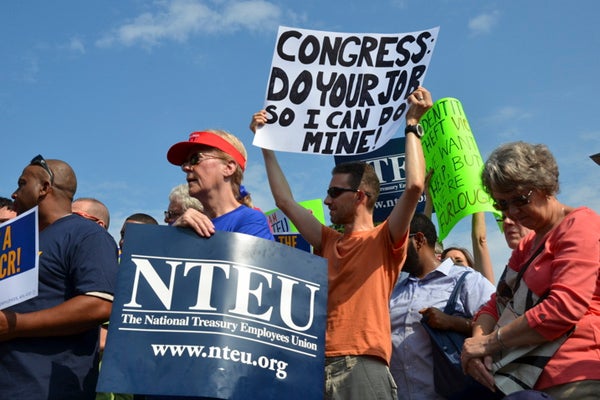|
September 25, 2014
The 2013 government shutdown affected federal workers and the U.S. economy, Stanford economist says
Stanford economist Constantine Yannelis found that federal employees during the 2013 government shutdown sharply reduced their spending and consumption levels. By Clifton B. Parker

Federal workers rally to protest the government shutdown in October 2013. (Photo: Keith Ellison/Creative Commons)
Brief as it was, the 2013 government shutdown was harmful to both federal employees and the U.S. economy, a Stanford economist says.
In a new research paper, Constantine Yannelis, a fifth-year Stanford doctoral student in economics, examined the income and spending levels of federal workers whose pay was interrupted during the highly politicized U.S. government closure from Oct. 1 to Oct. 16 in 2013.
During the shutdown, some federal employees were furloughed and others were required to report to work without knowing when they would receive paychecks.
In an interview, Yannelis said, "The U.S. government shutdown lowered consumption for the approximately 3 million federal government workers. Consumption is a large part of GDP, so this affected the U.S. gross domestic product, or GDP."
The Stanford Institute for Economic Policy Research published the article by Yannelis and co-author Scott Baker, a finance professor at Northwestern University. Yannelis noted the exceptional context that the shutdown offered for academic inquiry. "The 2013 federal government shutdown is different from other studied episodes as it is truly a transitory income shock," he said.
Worker spending curtailed
The researchers compared the incomes and spending of 154,459 federal and state employees. State workers were the "control" group, as they suffered no loss of pay. The data was derived from an online personal finance website.
The findings showed a sharp decline in income for federal workers during the shutdown, and afterward, a rebound in income. As for spending by federal workers, it dropped during the closure.
"We compute an approximate 2 to 4 percent drop in spending for federal workers, in comparison to state government workers who were unaffected by the shutdown. We do not see a comparable drop during other periods," said Yannelis.
He described the findings as a "violation" of an economic theory known as "permanent income theory." This theory, he said, posits that people determine their current consumption based not on their current income, but on their lifetime income.
"The shutdown did not affect workers' permanent income since they knew that their wages would be repaid after the shutdown ended," Yannelis said.
Thus, in a permanent income theory world, consumption should not have dropped for federal workers during the shutdown. "But we do see consumption drop in the data for federal workers during the shutdown," he said.
He explained that the workers' consumption choices were affected by the shutdown.
"I think one of the most important and novel findings of our research is that time allocation matters in consumption choices. The shutdown gives us variation in the time allocation of workers, as nearly all federal workers were not paid, but some were furloughed and sent home while others were required to work during the shutdown," Yannelis said.
They observed in the research a larger consumption drop for furloughed workers.
"These workers were sent home during the shutdown, so they had an increase in available time which can be used for leisure or home production," he said.
'Home production'
The drop in spending that was inconsistent with the permanent income model is best explained by credit constraints, home production and the substitution of leisure for consumption, Yannelis and Baker wrote.
Home production occurs when consumers choose not directly from the commodities that they purchase but from commodities they transform into goods through a household function. An example is when people eat at home instead of dining out at a restaurant, thereby saving money.
The research found that furloughed workers were motivated by a home production approach, and spent less on groceries, restaurants, babysitting, and lawn and garden items, for example. However, with that increase in leisure time, they spent more on entertainment, coffee shop visits and movies.
Yannelis noted the importance of research on government closures like the 2013 one. "This is important for many government programs, as lots of situations in which individuals receive benefits such as unemployment and retirement are associated with an increase in available time."
For more Stanford experts on economics and other topics, visit Stanford Experts.
-30-
|